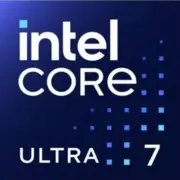Intel Core Ultra 7 165H

Intel Core Ultra 7 165H: Hybrid Power for Mobile Tasks
Overview of the Meteor Lake Processor for 2025 Laptops
Architecture and Technology Process: Evolution of the Hybrid Approach
The Intel Core Ultra 7 165H processor, built on a 7nm technology (effectively Intel 4), embodies the quintessence of the Meteor Lake hybrid architecture. Its structure includes:
- 6 Performance Cores (P-cores) with Hyper-Threading support (12 threads) and a base frequency of 3.8 GHz (up to 5 GHz in turbo mode).
- 10 Efficiency Cores (E-cores) without multithreading (10 threads).
- 2 Low-Power Efficiency Cores (LP E-cores) — a new feature in Meteor Lake for background processes.
In total: 16 cores and 22 threads, providing flexibility in task distribution. For example, video rendering utilizes P-cores, while background applications use E-cores.
Integrated Intel Xe LPG 128EU graphics is an evolution of the iGPU. It supports DirectX 12 Ultimate, ray tracing, and AV1 decoding, which is crucial for streaming. In Full HD gaming, it shows 40-60 FPS in Fortnite or CS2 on medium settings. By comparison, the previous generation Iris Xe (96 EU) delivered 15-20% less performance.
Power Consumption and TDP: Balance Between Power and Autonomy
The processor's TDP is 28 W, typical for premium ultrabooks. However, Intel has implemented several improvements:
- Dynamic Tuning 3.0 — an algorithm that redistributes load among cores to minimize energy consumption.
- Adaptive Voltage Management — reducing power usage in idle to 5-7 W.
As a result, even under peak loads (e.g., 4K rendering), the chip rarely exceeds 35 W, allowing for the use of compact cooling systems. However, in thin laptops (like the Dell XPS 14), the fans can become noisy under load—this is the price for high performance in a compact chassis.
Performance: From Office Tasks to Gaming
- Office Tasks: Running 50 tabs in Chrome + Word + Zoom — the processor utilizes E-cores, keeping the temperature below 50°C.
- Multimedia: Converting a 1-hour video in Premiere Pro takes 8-9 minutes (compared to 12-13 minutes with the Core i7-13700H).
- Gaming: In Cyberpunk 2077 (Low, FSR Performance) — stable 30 FPS. In Dota 2 (Medium) — 60-70 FPS.
- Turbo Mode: Maximum frequency of 5 GHz is maintained for up to 30 seconds (e.g., when opening a “heavy” project), after which it drops to 4.2-4.5 GHz to prevent overheating.
Important: For gaming at high settings, an external GPU (like the RTX 4050) will be required, but the iGPU is suitable for mobile scenarios.
Usage Scenarios: Who is the Ultra 7 165H For?
1. Creative Professionals: Photo editors, video editors, 3D designers who will appreciate multithreading.
2. Students and Office Workers: Quick document handling and multitasking.
3. Casual Gamers: For gaming on the go at medium settings or with an eGPU at home.
Examples of laptops:
- Asus ZenBook Pro 14 ($1499) — 32 GB RAM, OLED display.
- Lenovo ThinkPad X1 Carbon Gen 12 ($1699) — premium build, 18 hours of battery life.
Battery Life: How Long Will the Charge Last?
Under moderate load (web surfing, YouTube):
- A laptop with a 60 Wh battery (like the HP Spectre x360 14) lasts 10-12 hours.
Under maximum load (rendering):
- Battery life drops to 2-3 hours, but Intel Thread Director technologies optimize task distribution to save energy.
Tip: To extend usage time, activate the “Power Saver” mode in Windows — this will limit the frequency of P-cores to 2.5 GHz, adding 1.5-2 hours to your runtime.
Comparison with Competitors
1. AMD Ryzen 7 8840U (Zen 4, 8 cores/16 threads):
- Better for single-threaded tasks (Geekbench 6 Single-Core — 2450), but weaker in multi-threading (10500).
- iGPU Radeon 780M is comparable to Xe LPG but lags in rendering.
- Laptops are cheaper by $100-200 (e.g., Acer Swift 5 — $1299).
2. Apple M4 (3nm, 10 cores):
- Leader in energy efficiency (18 hours of battery life in MacBook Pro 14), but limited compatibility with Windows software.
- Starting price is $1999.
Pros and Cons
Strengths:
- High multi-threaded performance.
- Powerful integrated graphics.
- Support for Thunderbolt 5 and Wi-Fi 7.
Weaknesses:
- Laptop prices ($1400-1800) are higher than AMD counterparts.
- Underperforms even against budget discrete GPUs in gaming.
Laptop Selection Recommendations
1. Cooling: Look for models with a dual-fan system (like the MSI Prestige 16).
2. Display: For creativity — at least 100% sRGB, 400 nits.
3. Thunderbolt 5 Port: For connecting eGPUs or 8K monitors.
Avoid devices with passive cooling — they throttle under load.
Final Verdict
The Intel Core Ultra 7 165H is an ideal choice for those needing an all-in-one laptop: powerful for work, efficient on the go, and capable of light gaming. It is especially relevant for:
- Freelancers who work in various locations.
- Students in technical fields.
- Users updating their PCs every 4-5 years.
Key Benefits: A combination of performance and battery life, readiness for future upgrades (support for new standards), and premium device design. If your budget is $1300-1700, this is the optimal choice for 2025.
Basic
CPU Specifications
Memory Specifications
GPU Specifications
Benchmarks
Compared to Other CPU
Share in social media
Or Link To Us
<a href="https://cputronic.com/cpu/intel-core-ultra-7-165h" target="_blank">Intel Core Ultra 7 165H</a>